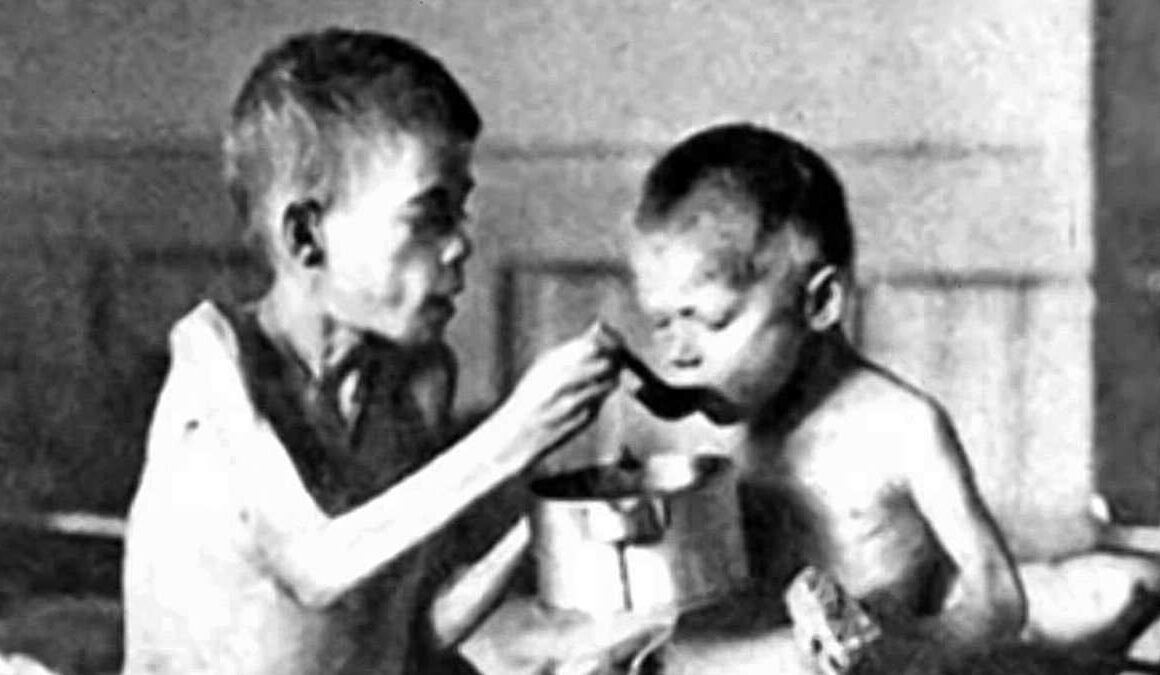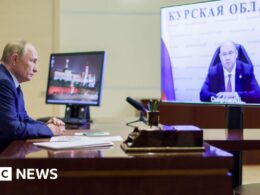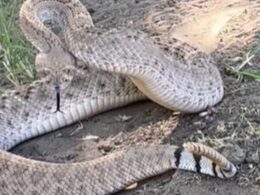Nearly four million people died of starvation in Ukraine in the early 1930s during a horrifying man-made famine that has irreparably scarred the fabric of Ukrainian society – but few today even know its name.
The Holodomor was once judged a ‘classic example’ of genocide by Raphael Lemkin, the Polish lawyer who coined the term after bearing witness to Nazi atrocities in World War Two.
An effort to suppress Ukrainian identity collided with a plot to extract grain to fuel burgeoning industrial centres in Russia, leading to mass starvation, disease and cannibalism as Soviet administrators did nothing to stop the tragedy.
Survivors told of parents facing starvation forced to eat the corpses of their children. Children saw siblings die in their homes, their bodies and eyes eaten by rats as those still alive were too weak to bury the corpses.
In its darkest moments, authorities executed those who made it through the brutal winter, judging that nobody could have survived such conditions without stealing from the state.
But for decades the atrocity went unmentioned, covered up by a deliberate campaign of obfuscation by the USSR. Ukrainians have lost their history to propaganda, buried reporting and the politicisation of the topic during the Cold War.
While many of the stories of the victims have been lost or buried, today’s historians continue to unearth the tragic realities of Stalin’s genocide in Ukraine. These are the stories that have survived.

Emaciated children pictured during the man-made famine that swept Ukraine in the 1930s

Dead and dying horses near a Belgorod collective farm during the Holodomor in 1934

The body of a young woman lies lifeless near Poltava during the Holodomor, in 1934

Josef Stalin enacted a brutal campaign of repression, exacerbating conditions made by Lenin
‘The good people died first,’ wrote historian Timothy Snyder of the Ukrainian famine.
‘Those who refused to steal or to prostitute themselves died. Those who gave food to others died. Those who refused to eat corpses died. Those who refused to kill their fellow man died.’
With few exceptions, all modern famines are man-made. The tragedy of the Holodomor, and all the individual stories below, is that it was avoidable.
Soviet policy dictated the requisitioning of grain, the seizure of private lands and the harsh punishments authorised for those who dared to steal.
And Soviet policy dictated the lack of support and the rejection of foreign aid as the people of Ukraine started to starve.
As the brutal winter of 1932/33 set in, with temperatures plummeting to -30C, the first reports of mass malnutrition and starvation began to emerge.
Ordinary people – workers, farmers, mothers, children – were driven to their physical and psychological limits as food was taken from Ukraine and redistributed in Russia.
Later, survivors would be horrified to understand how in a state of desperation they had cooked the corpses of their own family members just to stay alive.
Witnesses recounted stories of mothers killing their children in a fit of rage when the promise of food fell through, suffering hallucinations and delirium from late starvation as food reserves were exhausted.
People roamed the streets naked, broken. Ukraine never fully recovered.
Situated between the historic European powerhouses of Poland and Russia, Ukraine has long formed uneasy alliances with its neighbours for security.
At the turn of the 20th century, with revolution looming over Russia, Ukraine found itself bound to the dying Empire and then thrusted in to the fledgling Soviet Union.
Leon Trotsky – taking leading roles in the early Soviet government – soon suggested requisitioning grain from Ukraine, the so-called ‘breadbasket of Europe’, to foment support within Russia.
New towns and cities were drawing in workers as the country underwent a massive technological shift, and Ukrainian farmers would fuel the transformation by contributing their food for the ‘greater good’.
In the fifteen years leading to the Holodomor – literally, ‘hunger extermination’ -, Ukraine faced a brutal campaign of political repression that set the tone for the years to come.
Hundreds of pogroms took place across the region between 1918 and 1920, under Lenin. Cossacks were rounded up in their thousands and massacred by the authorities.
Ukraine fought for its independence, but the might of the Soviet Union crippled the population by deliberately restricting foreign aid and requisitioning huge quantities of food with imperial disregard for the victims.
But it was Josef Stalin who introduced the cruelest measures to destroy Ukrainian nationalism and divert aid from where it was most needed.
A policy of Collectivisation – abolishing the private ownership of land – saw hundreds of thousands lose control of their smallholdings, sparking nationwide rebellion.
Impossible quotas saw grain requisitioned from the lands at an astonishing rate as Stalin introduced a decree in 1932 stating that anyone – even children – caught taking any produce from a collective field would be shot or imprisoned.
Ukraine began to starve by spring 1932. Stalin withdrew all food aid to Ukraine to punish those opposing his bold ambition to drive industrialisation in the cities.
Contemporary testimonies collected by Ukrainian Cultural and Educational Centre provide rare and harrowing first-hand accounts of lives torn apart under the famine.
Writing in 1950, survivor Kashinska Hanna from Kherson – aged 20 at the time of the Holodomor – recalled how people were forcibly evicted from their homes in the dead of night as temperatures plummeted to -30C.
‘People were thrown out into the cold, not being allowed to take anything warn with them, even for children,’ she remembered.
‘The elderly, the sick and children died en masse on the road, and relatives who tried to help the dying died on the spot.’
Children began to balloon from malnutrition and dropped dead in the street as families were forced out onto the street in the middle of the Ukrainian winter.
Cases of the cannibalism of infant children became more common as desperate victims, translucent from malnutrition, were forced to make unimaginable choices just to stay alive.
Olga Mane, a young Polish woman interned by the USSR in 1935, said she met some of the ‘cannibals’ while held in a Gulag.
‘Shock and horror of the cannibals quickly passed,’ she wrote. ‘It was enough to see these unhappy, barefoot, half-naked Ukrainians.
‘They described how their children died of hunger, and how they themselves, very close to starvation, cooked the corpses of their own children and ate them.
‘This happened when they were in a state of shock and hunger. Later, when they came to understand what had happened, they lost their minds.’
Late stage starvation broke the minds of its victims. One mother was reported to have stabbed her son in a fit of rage after learning she had been sold bad bread, according to historian Anne Applebaum’s harrowing account of the ‘ Red Famine‘.
Bodies were left out to decompose in the streets as the few left alive to bury them lacked the strength to move them.

Historian Anne Applebaum wrote a detailed expose on the Holodomor for lay audiences
Malcolm Muggeridge, an English journalist who became The Manchester Guardian’s Moscow correspondent in 1932, reported: ‘The population is, in the most literal sense, starving; even in the large towns the food-shortage is acute…
‘The soil itself is impoverished, choked with weeds; at least 70 per cent of live-stock and horses have been killed to eat or have died of starvation.
‘The Communist Party, using its familiar weapons, hysterical propaganda and brutal coercion, is making a desperate effort to deal with this situation. On the success of its effort depends the whole future of the Soviet regime.’
But it would be another fifty years before knowledge of the Holodomor was widespread. Rather than looking to remedy the causes of the famine – or prevent further suffering – the USSR forbade its discussion in the press, cancelled visas for foreign journalists threatening to expose it, and refused to provide relief.
‘I met a man from England who told me that they knew about the famine in England,’ recounted survivor Maria Boratynska in 2009. ‘They offered to help, and were told that help wasn’t needed.’
The Soviet Union rejected foreign aid to Ukraine, denouncing those who offered it, as they extracted 4.27mn tons of grain from the region in 1932 alone. Records show the USSR had reserves to feed ‘well over 10 million people’ in early 1933 – but didn’t.

Nearly four million Ukrainians were starved to death during the Holodomor

Families were often forced out onto the streets, with Ukrainian winters dropping to -30C

Roman Slobodian and Feodosia with their children Maria, Antonina, and Ivan from Ziankivtsi village, Khmelnytsky district, Khmelnytsky region between 1931 and 1932. Sister Antonina (in the centre) died of famine in 1933

Second-grade pupils and a teacher from the village of Postavmuki in 1933. On the back of the given photo, there is an inscription: ‘…in memory of our 2nd grade…pupils who were there then and who died.’ A Holodomor witness claimed that only half of the pupils depicted in the photo survived the genocide
By the spring of 1933, authorities became suspicious that anybody still alive must still be harbouring food. Many are understood to have been shot on this basis alone – for having survived.
‘My father worked with the horses… When he was coming home, he took a handful of grain [used to feed them]. He did this a couple of times but got scared because if the brigadier found out, you would get ten years [in prison camps] for sure,’ Holodomor survivor Evhenia Bozhenko recalled in 2009, aged just 10-years-old in 1933.
‘I witnessed the mass death of whole villages due to [an] artificially introduced famine in Ukraine due to the disobedience of Ukrainians to the Soviet system and collectivisation,’ Kashinska Hanna said of the period.
‘Families I knew well from Obukhivka, where I was a teacher, starved to death for several weeks.’
She recalled visiting a family in the settlement in Dnipropetrovsk when spring came around.
‘Approaching two children in bed, one is trying to speak. I recognise the older one. I ask how she feels.
‘The answer was: ‘I’m afraid, because the rats are crawling on me, and Tanya has been dead for several days. Rats have eaten her eyes, and they are also crawling on me… and Peter and his father were taken away on Sunday by some people because they had died a long, long time ago.”
‘No one helps. No one from the authorities is interested,’ she concluded. ‘And the population is afraid to help, because they had to pay with their own lives to help the unfortunate.’
Around 3.9 million people are now estimated to have died as a direct result of the man-made famine in Ukraine between 1932 and 1933, around 13 per cent of the population.
In her book, Anne Applebaum cites an additional 600,000 births lost due to malnutrition.
There were ample opportunities to intervene. The tragedy of the famine was well-known in the USSR by early 1933.
Applebaum writes: ‘The evidence was in front of everyone’s eyes: the peasants at the railway stations, the reports coming from the countryside, the scenes in the cemeteries and morgues.

‘In the official, Soviet world the Ukrainian famine, like the broader Soviet famine, did not exist,’ writes Anne Applebaum
‘There is no doubt that the Soviet leadership knew it too. In March 1933, [First Secretary of the Communist Party of Ukraine, Stanisław] Kosior wrote a letter to Stalin in which he explicitly spoke of hunger… In April he wrote again…
‘But in the official, Soviet world the Ukrainian famine, like the broader Soviet famine, did not exist.’
Doctors would later recall being told to invent reasons for cause of death in starved Ukrainians. Politicians who referred to a ‘famine’ promptly lost their jobs.
Transparency was further obscured by the reflections of prominent Western writers supporting the Soviet project.
Sidney and Beatrice Webb, founded of the LSE and members of the socialist Fabian Society, visited the USSR during the Holodomor, but wrote in 1935 of its progress in technology and education.
George Bernard Shaw, a fellow Fabian, wrote that he did not see a single undernourished person during his visits.
Twelve years after the famine, George Orwell condemned the ‘majority of English Russophiles’ who had overlooked ‘huge events like the Ukrainian Famine of 1933, involving the deaths of millions of people’.

A boy next to the body of his father after the man was shot for approaching a prohibited area of a farm while picking grain, 1934

Children witnessed family members eaten by rats at the height of the avoidable famine

Two boys with a cache of potatoes they have found in 1934. The food had been hidden by an elderly woman, who was raided by the GPU and deported to Siberia for hoarding food

Maria Vobla and her son Vasyl, between 1926-28. Vobly Oleksiy Vasyliovych (born 1881) and his wife, Maria, rescued children during the Holodomor
Stalin eventually backed off, ending the policy of requisitioning but maintaining Collectivisation and denying outright that the Holodomor had happened. Instead, he boasted of his victory over the [land-holding] Kulaks.
Grain and seeds were only loaned back to Ukraine, which remained under the grip of the USSR until its collapse in 1991. People stopped dying of hunger, but life was forever changed.
The Holodomor had delivered a crushing blow to Ukrainian identity as political opponents were rounded up and killed. Local history was not taught, and the language was suppressed.
This was not simply an abstract loss of political independence, but the erasure of a distinct local history developed over centuries.
The Tatars of Crimea, who had lived on the peninsula for more than 500 years, lost touch with their roots, deported en masse in 1944.
Russian migrants were encouraged to move to the region – with consequences informing the shape of conflicts of the peninsula to this day.
And so, even upon independence, many Ukrainians in the east would turn back to Russia for work as they lost touch with their language and culture, viewing Ukraine as something of a backwards province.
In the West, some revolutionaries moved by the events of the 20th century had tried to foment a new ‘version of a Ukrainian national identity that sought to stand alone between the twin evils of Polish and Russian nationalism’, according to British historian Andrew Wilson.
Leaders judged Poland Ukraine’s ‘oppressor’ – but Russia was its ‘existential antithesis’. They identified Ukraine’s future role ‘defending the rest of Europe from the scourge of Bolshevism – and save itself by such opposition.’
But a national movement for Ukraine would only gather any momentum in 1991, after the fall of the USSR.
Ukraine has struggled to adapt to a market economy and stand on its own feet, however. By 2020, it remained the poorest country in Europe and was left open to foreign manipulation.
The early politics of independence were marred by internal corruption and strained by revolution.
But since the ousting of pro-Russian President Viktor Yanukovych in 2014, Ukraine has battled to secure its own freedom to choose its leaders and allies.
Russified populations in regions such as the Donbas and Crimea continue to prove a challenge to unifying a distinct Ukraine.

Two women prepare to leave their homes with just four bags containing their possessions as they are evacuated from the Donetsk region of Ukraine, near the frontline, on July 30

Ukrainian infantrymen take a moment of respite near the frontline in Dontesk region, July 19

Ukrainian troops fire a tank towards Russian positions in the Serebryanskyy forest on July 19

Views of damage and devastation following shelling in the town of Toretsk on June 25
Despite attempts to undermine, downplay and destroy the Ukrainian identity, the people of Ukraine retain a sense of self borne of more than simple contrast to their neighbours.
Ukrainian history is linked to Polish, Russian and Belarusian history. But the material and ideological conditions of the region, and the shared experiences through events like the Holodomor, have given rise to a people distinct.
Raphael Lemkin judged the Holodomor the ‘classic example of Soviet genocide’. The term would later inform the definition as acts ‘having intent to destroy, in whole or in part, a national, ethnic, racial or religious group, as such’.
It has been nearly 90 years since the Holodomor ended. But Ukrainians today continue to fight not only for land but for the claim to an identity of their choosing, to live without interference and to be free.








